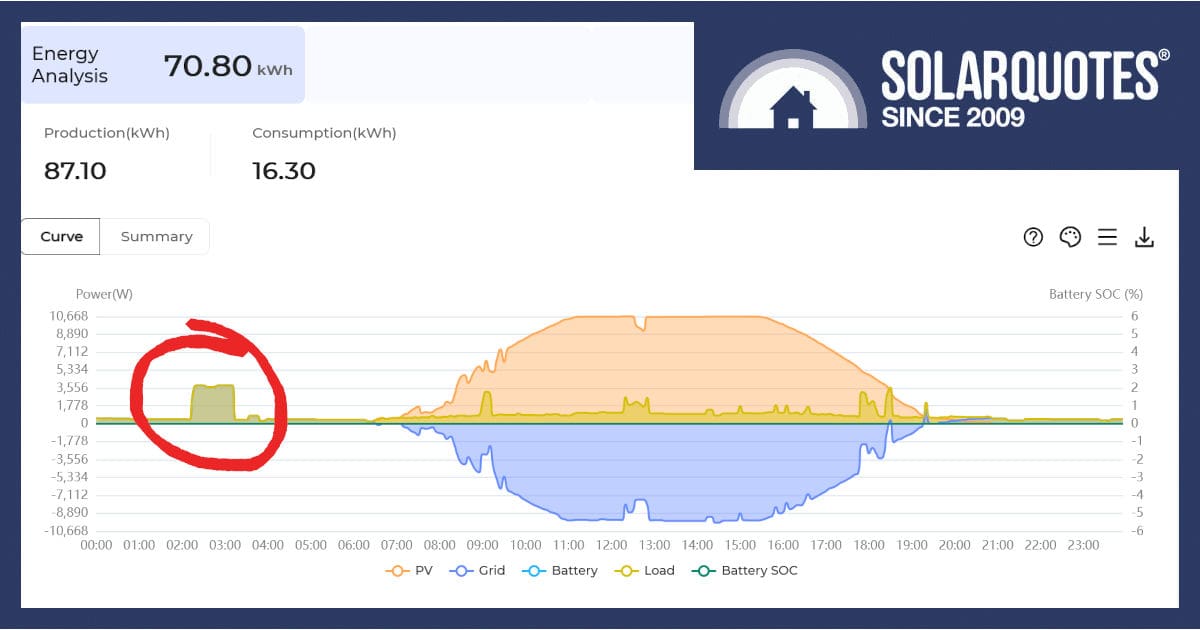
Circled in red, hot water consumption should be under the solar curve
In this story, we’ll outline a great quality system, expertly installed and supported by an exceptional solar company, then a saga of customer complaints, despite the system performing better than promised.
Solar power systems are a modern marvel. They turn sunlight into savings, but they’re not magical. They’re subject to the laws of physics, the realities of weather, and the limitations of grid infrastructure.
Misaligned expectations and a communication breakdown can lead to frustration on all sides.
This isn’t just a tale of one disgruntled customer; it’s a word of caution for anyone engaging trades. Here’s why managing expectations and maintaining civility matters, and what you can learn from this scenario to avoid the same pitfalls.
A Solar Success Story—Or Is It?
The Sungrow system in question was an expertly designed and installed setup, including:
- High-quality panels with modern split-cell technology for better shading tolerance.
- Smart data gathering using native monitoring from Sungrow’s iSolar Cloud
- A system design that, based on months of real world data, outperformed the quoted estimates.
Yet, despite this, the customer complained about the system’s performance, particularly in the morning when shade from tall trees on the median strip cast a shadow on the front of the house and parts of the array that faced East.
Why the System Starts Slow
The main complaint was about the system lacking morning output. The customer noted the inverter “wakes up” around 6:30 a.m. but takes time to generate significant energy.
This isn’t unusual. In the early morning, sunlight passes through more of the atmosphere, reducing its intensity. As the sun rises, the light becomes more direct, and energy production ramps up.
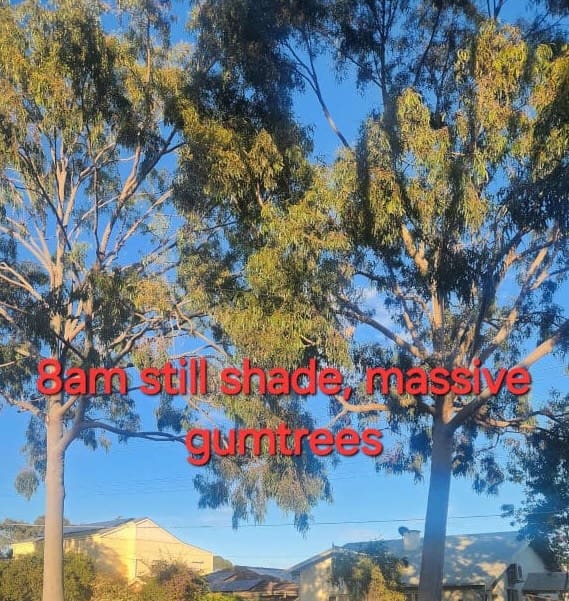
The morning shade was particularly bad in winter
Though it’s bleary-eyed in the morning sun, the output grows slowly but surely for an hour or more. When the sun clears the trees, this system gets its socks on and goes.
Shading: The Real Culprit
Split-cell solar panels are effectively two panels under the same piece of glass. However, shading losses are still a reality, and they are likely the root cause of this complaint.
When the installer explained, “Modern panels will work in the shade,” he meant they’ll cope. A saucer-sized patch of shade won’t cripple ⅓ of your panel.
The customer misinterpreted “modern panels will work in the shade” to think they could magically create energy from nothing.
Analysing The Evidence
I sought a trial of Solar Analytics for this job in order to get unquestionably independent and unbiased advice. Even though it’s free for the first month, the complainant waxed and waned about enabling it.
Solar Analytics uses an algorithm to identify persistent shading patterns in the yield curve (e.g., trees) and estimate the percentage of energy lost.
Random curtailment events like export throttling won’t be picked up. However, there’s always a degree of approximation.
In this instance, shading was already accounted for in the system design, and moving panels to avoid it wouldn’t have improved performance, but it’s nice to have a number for it.
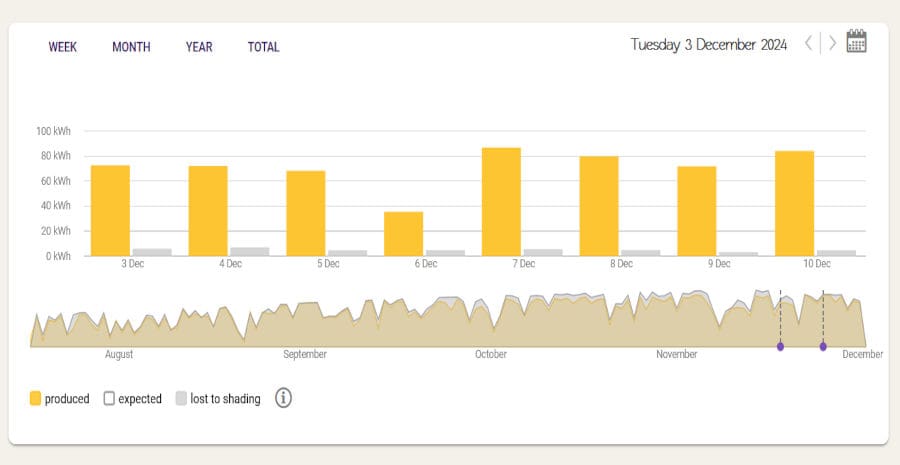
Shading represents perhaps 4 or 5kWh lost each day, compared to an “ideal” system.
What’s Behind the “Flatline”?
The customer exclaimed the system was “flatlining” in the early morning.
Now, in the first instance, the yield was growing, just that it was slow. To confuse matters, SAPN’s flexible export throttling has kicked in later on some mornings. This grid-management policy designed to prevent overloading during peak solar generation times, puts a truly flat ceiling on solar export.
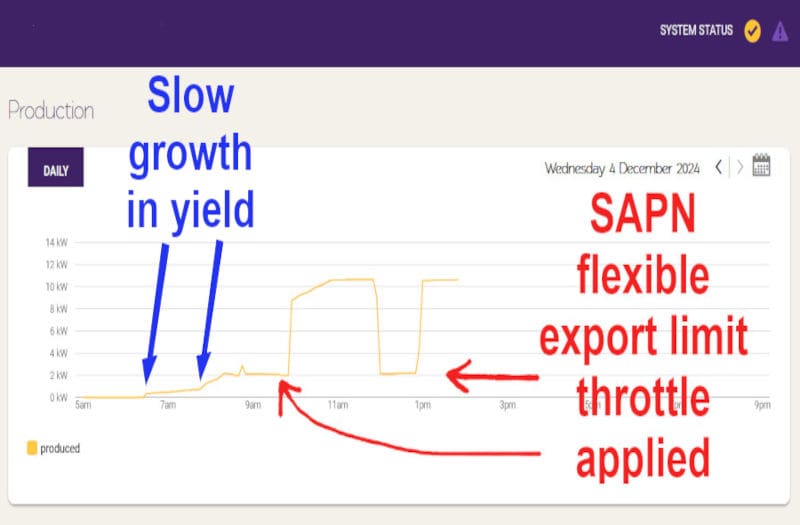
What the customer called a flat line was a gentle slope
This throttling isn’t a fault in the system. It’s part of living in a region with high solar penetration. Still, it can be confusing for customers, especially when they are already suspicious about yield.
Graphs That Tell the Story
Shading is a common challenge for solar systems, especially in urban areas with trees, buildings, or other obstructions. The initial system design saw the bulk of the capacity facing North. While some faced West, there wasn’t an East-facing array to catch the morning light.
This quote was accepted, and the contract began with yields estimated in blue.
As this suburb is suffering some gentrification, the customer worried some panels may be overshadowed if the neighbours build a two storey house.
It was agreed that some East facing solar would be a good idea. Although some aesthetic concerns were ventilated, the installer assured it would be a better outcome, which is borne out in the yellow columns below.
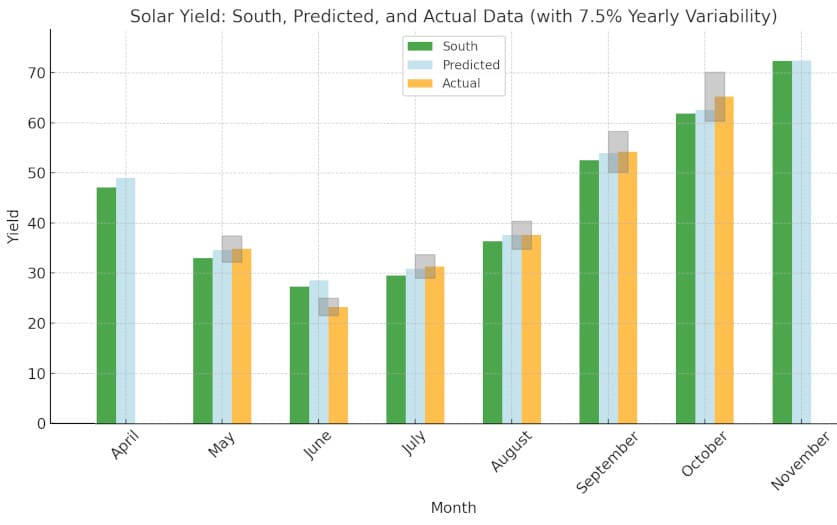
June hasn’t quite measured up to the estimates, but the actual measured yield is close otherwise.
Real World Results Exceed The Quoted Design
It was put to me that all 8 panels on the front of the house should have gone on the south side. It’s not the first time I’ve had a customer try to make a technical argument over an aesthetic opinion…
As I’ve written before, south shouldn’t be discounted, but it’s almost always the last option.
To test the theory that south-facing solar in the sun was better than east-facing solar in some shade, I ran a separate design through the software.
As the green columns show, there’s no point in moving panels to the south side of the house, the best trick is simply add more.
The key takeaway: The system worked better than promised, proving that the design was accurate and the installation was electrically right.
The original design at the top and the executed system at the bottom, which performs better.
Data Revealed More Savings Going Begging
Being unable to fell trees or bend light, my advice for reducing electricity bills further included:
- Hot water diversion. Installing a Catch Control or sunshine circuit to divert excess solar energy into a hot water system, eliminating the need for off-peak grid power. (see the graph in the header image)
- Battery storage. Using tools like the SolarQuotes Battery Calculator or Solar Analytics to determine what size battery would deliver a good return on investment.
- Optimising the retail plan. Using Solar Analytics to identify better energy plans based on actual usage patterns.
With these steps, the customer could have significantly reduced their bills, but the advice was largely ignored.
Solar Is a Long-Term Asset
Solar power isn’t a one-and-done purchase. It’s a long-term asset that requires ongoing monitoring, periodic maintenance every 5 years at least, and occasional adjustments may be needed if you have a change in WiFi network or automation for things like hot water or battery. This case highlights a few key lessons:
- Manage expectations. Understand that solar performance varies with weather, grid conditions, and seasonal factors.
- Document your requirements. Ensure your installer designs the system to meet realistic goals, not idealised ones.
- Trust the experts. Installers and monitoring tools like Solar Analytics are there to help. If they tell you the system is working, it probably is.
- Maintain civility. A respectful relationship with your installer is essential for the long-term success of your solar investment.
The Importance of Solar People
Aside from having to bite my tongue, the most frustrating part of this case was the customer’s behaviour.
Despite the installer’s exhaustive efforts to explain the system, provide analysis, and offer solutions, the customer responded with impatience, suspicion, and even hostility.
Solar installers aren’t just service providers—they’re long-term partners and in my experience, they care about what they do.
Systems come with warranties that span 10–20 years, and maintaining a good relationship with your installer is essential for warranty support, maintenance, and upgrades. Keeping people onside just makes sense.
Final Thoughts: Don’t Be That Customer
This story isn’t just about one unhappy customer; it’s about the importance of education, communication, and mutual respect.
Solar is an incredible technology that can deliver decades of clean energy and financial savings, but only if you approach it with the right mindset.
By understanding your system, trusting your installer, and staying realistic about its limitations, you can avoid unnecessary angst and make the most of your investment.

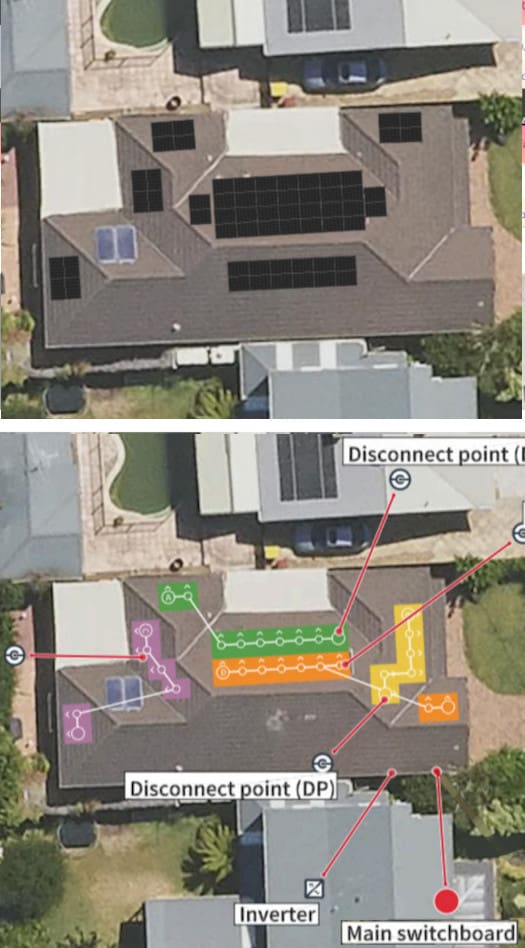
 RSS - Posts
RSS - Posts



Thanks for an excellent article. Especially re the export curbing.
I noticed, my energy provider switches on, off-peak electricity after the morning peak demand, which then heats my water with coal-fired energy before my evacuated tubes get a chance to heat my water with sunshine.
Most people are blissfully unaware this is happening, but I have installed a little LED light which tells me when off-peak electricity is available, and I manually switch my off-peak hot water system off and save money. They do it again after the lunchtime peak. This action defeats your solar hot water system and forces you to buy more electricity you don’t need.
Nice work. I work for local government, and I have people ring to complain when they reverse into stationary poles that are clearly visible, claiming it isn’t their fault.
Society as a whole is more angry and intolerant and just plain nuts now. A very difficult time to keep anybody happy, let alone customers.
Hmm, realised the roof diagrams were mock ups . . . was trying to work out this system size.
How many KW was this set up ?
Is it unusual to see nearly 5 hours of clipping at max 10kw inverter size ?
Hi Les,
10kW single phase inverter with 440w modules… 13.2kWp
Export limiting is highly variable but our manager Trev has seen his exports rise significantly when moving his 20kWp system from 5kW fixed to flexible.
Thanks for the update on system size.
13.2kw makes sense to me, and feel a little better about our 11.23kw system.
With 2 phases and 2 x 5kw inverters, we find it peaks out at about 9.3kwh on a good day, putting out about 78kw total.
We haven’t had any export limiting in our area so far, just a small SAPN test back a few months.
Hopefully that will remain until we eventually get a battery.
Without an explicit pointer, I assume that the orientation in the photographs, of the view from above, is that the upward direction is north?
Whilst the details are missing from the above article, of the total panels generating capacity, and the inverter nominal capacity, with the monitoring display showing 87.1kWh of generation, and 16.3kWh of consumption (assuming that to be total consumption and not only consumption of generated power), with a surplus of 70.8kWh, I wonder why the customer did not get a hybrid inverter with a battery system with capacity of at least a day’s average total consumption, which could thence be charged from the grid, using time of use pricing, during the least expensive grid pricing; if charging from the grid, is needed during the times of less available sunlight. The inclusion of such a battery system, would overcome the periods of shade inhibiting the PV generation.
Also, from the picture that shows the PV panels with black colouring, two panels are shown, with light grey colouring, that, I assume, are panels for a solar water heater. I am wondering why, if that is correct, the boosting of the solar HWS heating, is not also done when the grid electricity price is cheapest (which should also coincide with when the PV system is producing).
Here on the bodgy SWIS grid, I have a big solar HWS, from which, the output water is fed into a big gas storage water heater, so, providing a big supply of solar heated hot water, that is only heated if needed, with bypass valves to provide for hot water, should either water heater fail. I understand that “natural gas” is cheaper in WA, than in the eastern states. Unfortunately, whilst water heated by the solar HWS can be fed into the gas storage water heater, the electric heat pump water heaters (EHPWS) apparently do not allow for water heated by a solar HWS, to be fed into them (and, in WA, hot water is banned for new HWS’s). Perhaps am EHPWS with least expensive TOU charging, would be worthwhile
Hi Bret,
Don’t worry about the price of gas, they’re allowing the exporters to suck up domestic gas in WA now.
With larger volumes being compressed, refrigerated & shipped out, the price will climb to world parity like the east coast soon…
Solahart was always big in WA because of the SWIS not having overnight off peak AFAIK.
There should be no reason why a split system pumped solar hot water collector can’t use a heat pump tank but you will probably need a clever plumber and a few dollars which sine find hard to justify.
I would contact Earthworker and get a Reclaim heatpump. The compressor units should last forever I’d it’s solar boosted.
I think you meant to say “won’t cripple” rather than “won’t triple”.
Thanks Harry,
We’ve fixed it up. You’re a better than a robot editor in this case.
Cheers
Used to proof read a lot of PhDs, it’s a knack developed over many years
A good skill Harry.
You’ll have to tune up the senses to spot AI hyperbole & marketing speak… it’s the bane of my existence.
Very well told story.
I think we have all had customers with unreal expectations and been caught more than once.
I think if the customer was presented with a solar pathfinder shade analysis report stating low morning solar production then a different location may have been chosen.
There are still of a lot of solar shoppers who believe Google over qualified designers like us.
Happy solar
Rod Grono